
Mulch Paper is the process or practice of covering the soil/ground to make more favourable conditions for plant growth, development and efficient crop production. Mulch technical term means ‘covering of soil’. While natural mulches such as leaf, straw, dead leaves and compost have been used for centuries, during the last 60 years the advent of synthetic materials has altered the methods and benefits of mulch Paper. The research as well as field data available on effect of synthetic mulches make a vast volume of useful literature. When compared to other mulches plastic mulches are completely impermeable to water; it therefore prevents direct evaporation of moisture from the soil and thus limits the water losses and soil erosion over the surface. In this manner it plays a positive role in water conservation. The suppression of evaporation also has a supplementary effect; it prevents the rise of water containing salt, which is important in countries with high salt content water resources.
mulch paper is the process or practice of covering the soil/ground to make more favourable conditions for plant growth, development and efficient crop production. Mulch technical term means ‘covering of soil’. While natural mulches such as leaf, straw, dead leaves and compost have been used for centuries, during the last 60 years the advent of synthetic materials has altered the methods and benefits of mulch paper. The research as well as field data available on effect of synthetic mulches make a vast volume of useful literature. When compared to other mulches plastic mulches are completely impermeable to water; it therefore prevents direct evaporation of moisture from the soil and thus limits the water losses and soil erosion over the surface. In this manner it plays a positive role in water conservation. The suppression of evaporation also has a supplementary effect; it prevents the rise of water containing salt, which is important in countries with high salt content water resources.


Mulch paper is mainly employed for:-
A wide range of plastic films based on different types of polymers have all been evaluated for mulch paper at various periods in the 1960s. LDPE, HDPE and flexible PVC have all been used and although there were some technical performance differences between them, they were of minor nature. Owing to its greater permeability to long wave radiation which can increase the temperature around plants during the night times, polyethylene is preferred. Today the vast majority of plastic mulch is based on LLDPE because it is more economic in use.
Normally the thickness of the film does not affect the mulch paper effect except when it is used for solorisation. But some of the recent references do indicate the impact of film thickness on crop yield. Since it is sold by weight it is advantageous to use as thin a film as possible but at the same time due consideration should be given for the longevity of the film. The early mulch film used were of 60-75 micron (240-300 gauge) thickness, and today it is possible to have 15 micron thick film due to advent of film extrusion technology. These films are mechanically weak, as shown by their easy tearing when pulled tension.
This depends upon the inter row spacing. Normally a one to one and half meter width film can be easily adopted to different conditions.
The perforations may be advantageous under some situations and disadvantageous for some other situation. The capillary movement of water and fertilizer distribution will be better and more uniform under unperforated condition. But for prevention of water stagnation around the plants, perforation is better. But it has got the disadvantages of encouraging weed growth.
The colour of the mulch affects
Transparant film:- Deposits more salt on soil surface.
Black film:- Restricts water movement and upward movement of salt is reduced.
Weed flora:- Black film
Insect control:- Opaque while film acts as golden colour and attracts insects
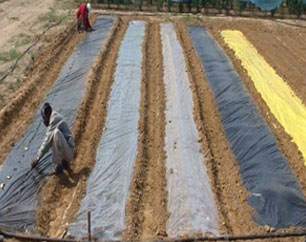
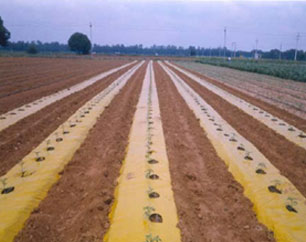
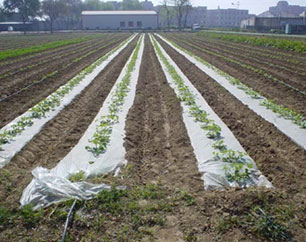
The selection of mulches depends upon the ecological situations and primary and secondary aspects of mulch paper
|
Rainy season |
Perforated mulch |
|
Orchard and plantation |
Thicker mulch |
|
Soil solarisation |
Thin transparent film |
|
Weed control through solarisation |
Transparent film |
|
Weed control in cropped land |
Black film |
|
Sandy soil |
Black film |
|
Saline water use |
Black film |
|
Summer cropped land |
White film |
|
Insect repellent |
Silver colour film |
|
Early germination |
Thinner film |
The mulch material should be punctured at the required distances as per crop spacing and laid on the bed. The seeds/seedlings should be sown/transplanted in the holes.
In case the mulch film needs to be used for more than one season (thicker film) the plant is cut at its base near the film and the film is removed and used.
By compounding appropriate additives into the plastics it is possible to produce a film, which, after exposure to light (solar radiation) will start to breakup at a pre determined time and eventually disintegrated into very small friable fragments. The time period can be 60, 90, 120 or 150 days and for maize a 60-day photodegradable mulch is used. However there are still some further problems to resolve. It has been observed that the edges of the mulch, which are buried to secure the mulch to the soil, remain intact and become a litter problem when brought to the surface during the post-harvest ploughing. Currently much development effort is being made to find a satisfactory solution to this problem.
In direct contrast in developing countries which have agricultural labour available a different approach can be made. Fro example in the people Republic of China trials have been made using a plastic mulch of 15 micron thickness on a sugarcane crop. After the cuttings have been planted through the mulch they are left to grow for a period of one month. Then the mulch is removed by hand and wound up so that it can be utilized for a second season. A yield increase of 26% was obtained.
These two examples not only demonstrated the diversity of mechanisms available for resolving the problems of mulch removed, but also illustrate the different technique, which have been developed in different countries. It also indicates the necessity for each country to adapt and develop mulch paper technique to meet its own specific requirements of climate, resources and economics. To undertake such technology development there is a specific requirement that both plastics and agricultural development facilities are available.
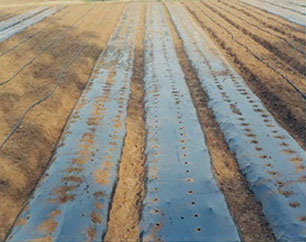
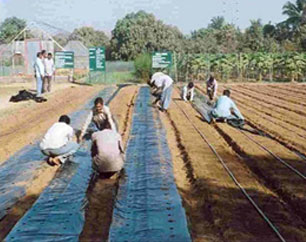
The cost economic of mulch paper is an important aspect. In a leveled field if mulch paper is to be done, then the film area required will be almost equal to that of field itself. In fields with ridges and furrows mulch paper material required will be sizably more than the field area. However mulch paper is carried out in strips covering 50-60% of field area. In the present era of minimizing rainfall conserving moisture with mulch paper transgresses the plan of economic analysis in the sense that the real cost analysis would be even meaningless in the case of a precious commodity like water. A typical calculation has been given for working out cost economics of mulch paper in Bhendi crop.
|
Sl. No. |
Particulars |
Black LLDPE film |
Control |
|
1 |
Cost of cultivation (Rs. / ha) |
16000 |
21000 |
|
2 |
Cost of mulch film per season |
16600 |
-- |
|
3 |
Total seasonal cost (2+1) |
32600 |
21000 |
|
4 |
Yield of produce (kg/ha) |
11660 |
7770 |
|
5 |
Market price (Rs./kg) |
6.00 |
6.00 |
|
6 |
Revenue (Rs./ha) |
69960 |
46620 |
|
7 |
Total expenditure |
32600 |
*21000 |
|
8 |
Net income |
37360 |
25620 |
|
9 |
Difference in net seasonal income |
11740 |
25620 |
|
10 |
Benefit cost ratio |
1.45: 1 |
|
| * 60% area covered with film, | 50 micron film of 1 kg cover 22 sq. m | ||
An experiment on mulch paper with plastic films was conducted for groundnut Aliyarnagar Research Station. The film was LLDPE black and the thickness were 15 micron (T10, 20 micron (T2), 25 micron (T3), coir pith at the rate of 20 t/ha (T4) and fifth plot was control (T5). Each plot was 2m x 1m and experiments were replicated four times. For sampling purpose, 5 plants in each of the experimental plots were considered for rot length on 60th day. The crop was harvested on 110th day since sowing. Parameters like soil moisture, soil temperature, germination; weed, root and yield were observed.
|
Treatment |
Available moisture at harvest (%) |
Wet weed wt. (g)/plot at 45th day |
No. of pods/plant |
Pod yield (kg/ha) |
|
T1 – 15 micron LLDPE (black) |
7.69 |
150 |
9.00 |
1337 |
|
T2 – 20 micron LLDPE (black) |
7.62 |
156 |
7.75 |
1118 |
|
T3 – 25 |
7.05 |
179 |
7.50 |
1275 |
|
T4 – Coir pith 20 t/ha |
6.50 |
257 |
6.75 |
1012 |
|
T5 Control – no mulch |
5.90 |
370 |
6.75 |
850 |
Mulch paper with 15 micron LLDPE film was found to give higher pod yield due to better moisture conservation, reduced weed growth, when compared to coirpith mulch and control. From the results it was also seen that the thickness of film did not matter much in conserving moisture.

Experiments were conducted at TNAU, by PDC, CAE for dry land cotton, covering 50% of land area by 25 micron LLDPE black polyethylene film. The replicated trial was repeated for 3 seasons from 1992-93 for LRA 5166 cotton variety. For comparative study purpose coir pith at a rate of 12.5 t/ha and organic mulch of 12.5 t/ha were also taken. Plot size was 5 m x 4 m.
To study the effect of mulch paper on plant height and root length under dryland conditions plants like redgram and castor crop were selected and trials were conducted at TNAU campus. The results are as shown below:
|
Treatment |
Red gram (SAI) |
Castor (CO 1) |
||||
|
Plant height (cm) |
Root length (cm) |
Root No. |
Plant height (cm) |
Root length (cm) |
Root No. |
|
|
30 mic. LLDPE black |
45.0 |
25.3 |
5 |
50.1 |
38.3 |
8 |
|
40 mic. LLDPE black |
41.6 |
20.7 |
3 |
48.7 |
35.8 |
5 |
|
50 mic. LLDPE black |
41.9 |
23.0 |
3 |
48.0 |
34.3 |
5 |
|
No mulch |
22.1 |
20.9 |
4 |
30.1 |
28.6 |
6 |
From the year 1986 onwards, Coimbatore PDC is continuously conducting experiments on mulch paper for principal vegetable crops like Bhendi, Tomato and Chilli. Replicated trials were conducted with three irrigation levels and two type of mulches as follows.
The plot size was 5.5 m x 2.5 m/each
Each experiment was repeated thrice in different season for the same variety of crop for confirming the results. The mean values of yields of each crop are tabulated below.
Effect of mulch paper on Bhendi yield (4 year average) in kg/ha
|
Treatment |
M0 |
M1 |
M2 |
Mean |
|
I1 |
6593 |
8249 |
11292 |
8698 |
|
I2 |
8145 |
9156 |
12173 |
9825 |
|
I3 |
8571 |
8686 |
11555 |
9604 |
|
Mean |
77770 |
8697 |
11660 |
|
Effect of mulch paper on tomato yield
Mean yield data over three years
|
Treatment |
M0 |
M1 |
M2 |
Mean |
|
I1 |
8322 |
10260 |
11767 |
10116 |
|
I2 |
9527 |
11415 |
13012 |
11318 |
|
I3 |
11916 |
12326 |
13427 |
12556 |
|
Mean |
9922 |
11334 |
12735 |
|
|
|
|
(14.2)* |
(28.4)* |
|
*Percentage of yield increase over unmulched control / plot
Effect of mulch paper on Chilli yield
Mean yield data over three years
|
Treatment |
M0 |
M1 |
M2 |
Mean |
|
I1 |
3972 |
4353 |
4916 |
4414 |
|
I2 |
4732 |
5115 |
5475 |
5107 |
|
I3 |
4940 |
5359 |
5872 |
5390 |
|
Mean |
4548 |
4942 |
5421 |
|
Experiments conducted in TNAU main campus showed that evaporation loss from the maize crop field can be arrested by covering the soil either with plastic film of 20 micron (80 gauge) of black sheet or with organic farm waste like cumbu straw. Due to this water economizing to the level of 12-20% was achieved. Hence it is a viable technology under moisture stress condition.
|
Treatment |
Seasonal total water (mm) |
Yield in kg/ha |
WUE (kg/ha mm) |
|
1. Control |
463 |
5562 |
11.90 |
|
2. Plastic mulch with 20 micron |
373 |
5650 |
15.10 |
|
3. Cumbu straw |
401 |
5594 |
13.90 |
|
4. Coir pith |
403 |
5466 |
13.86 |
Plasticulture is crucial to Indian agriculture in view of the changing technological scenario for boosting crop yields and productivity. Introduction of linear low density polyethylene (LLDPE) as a mulch film has brought a revolution in agricultural water management. It is actually a boon to dryland farmers. This is one of the fastest growing plasticultural applications in the world. The cost of LLDPE film is also lesser than one third of LDPE mulch film. Moreover for mulch activity lower thickness (15 to 20 microns) are highly suitable. However due to ever increasing cost of raw materials the films are costlier now. Hence Government should take all possible measures to produce the film in a mass scale and make it available to the farmers at a reasonable price. Subsidy may also be given through banks to encourage the farmer to adoption soil mulch paper. Low cost machines may be developed for spreading and rolling down the film in the field. PFDC’s may be geared up for large scale demonstration in farmer’s field to give a wide publicity.
Studies on mulch paper at various centres of PFDC's all over India
|
Sl. No. |
Crop |
Location of PFDC |
Mulch material |
Increase in yield (%) |
Additional income (Rs./ha) |
|
1. |
Chilli |
Navasari (Gujarat) |
Black plastic (50 micron) |
60.1 |
10140.00 |
|
2. |
Brinjal |
Navasari (Gujarat) |
Black plastic (50 micron) |
27.1 |
7400.00 |
|
3. |
Sugarcane |
Navasari (Gujarat) |
Black plastic (50 micron) |
50.2 |
25000.00 |
|
4. |
Chilli |
Navasari (Gujarat) |
Green plastic (50 micron) |
59.0 |
22190.00 |
|
5. |
Cauliflower |
Hisar |
Black plastic (50 micron) |
31.9 |
6751.00 |
|
6. |
Potato |
Pantnagar (UP) |
Black plastic (50 micron) |
35.5 |
8700.00 |
|
7. |
Cauliflower |
Pantnagar (UP) |
Black plastic (50 micron) |
71.0 |
16120.00 |
|
8. |
Tomato |
Pantnagar (UP) |
Plastic film (25 micron) |
46.5 |
11250.00 |
|
9. |
Okra |
Pantnagar (UP) |
Plastic film (25 micron) |
47.85 |
9250.00 |
|
10. |
Tomato |
Pantnagar (UP) |
Plastic film (25 micron) |
79.2 |
22764.00 |
|
11. |
Tomato |
Kharagpur (WB) |
Plastic film (25 micron) |
65.4 |
43210.00 |
|
12. |
Okra |
Kharagpur (WB) |
Plastic film (25 micron) |
55.1 |
19625.00 |
|
13. |
Guava |
Delhi |
Plastic film (100 micron) |
26.0 |
-- |
|
14. |
Lemon |
Delhi |
Plastic film (100 micron) |
21.6 |
-- |
|
15. |
Kinnow |
Delhi |
Plastic film (100 micron) |
46.8 |
-- |
|
16. |
Pomogranate |
Delhi |
Plastic film (100 micron) |
33.3 |
|
|
17. |
Brinjal |
Coimbatore |
Plastic film (25 micron) |
33.3 |
12062.00 |
|
18. |
Bhendi |
Coimbatore |
Plastic film (25 micron) |
46.7 |
9770.00 |
|
19. |
Bhendi |
Coimbatore |
Plastic film (25 micron) |
54.0 |
6400.00 |
|
20. |
Chilli |
Coimbatore |
Plastic film (25 micron) |
18.6 |
6800.00 |
|
21. |
Groundnut |
Coimbatore |
Plastic film (15 micron) |
20.5 |
7300.00 |
|
22. |
Banana |
Travacore (Kerala) |
Plastic film (50 micron) |
12.6 |
13906.00 |
|
23. |
Arecanut |
Travacore (Kerala) |
Plastic film (50 micron) |
28.4 |
-- |
|
24. |
Bhendi |
Travacore (Kerala) |
Plastic film (50 micron) |
25.0 |
18885.00 |
|
25. |
Maize |
Rajendranagar (AP) |
Plastic film (25 micron) |
44.6 |
9800.00 |
|
26. |
Brinjal |
Rajendranagar (AP) |
Plastic film (25 micron) |
10.0 |
15100.00 |
|
27. |
Bhendi |
Rajendranagar (AP) |
Plastic film (25 micron) |
67.0 |
18300.00 |
|
28. |
Tomato |
Rajendranagar (AP) |
Plastic film (25 micron) |
65.3 |
13800.00 |
|
29. |
Plum |
Solan (HP) |
Plastic film (50 micron) |
9.2 |
12000.00 |
|
30. |
Tomato |
Solan (HP) |
Plastic film (50 micron) |
85.6 |
18250.00 |
|
31. |
Pea |
Solan (HP) |
Plastic film (50 micron) |
66.6 |
25960.00 |
|
32. |
Apricot |
Solan (HP) |
Plastic film (50 micron) |
33.3 |
18320.00 |
|
33. |
Peach |
Solan (HP) |
|
31.2 |
13890.00 |
